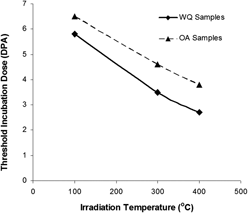Article contents
Effects of alloying elements on the formation of <c>-component loops in Zr alloy Excel under heavy ion irradiation
Published online by Cambridge University Press: 14 April 2015
Abstract

We report here the microstructural changes occurring in the zirconium alloy Excel (Zr–3.5 wt% Sn–0.8Nb–0.8Mo–0.2Fe) during heavy ion irradiation. In situ irradiation experiments were conducted at reactor operating temperatures on two Zr Excel alloy microstructures with different states of alloying elements, with the states achieved by different solution heat treatments. In the first case, the alloying elements were mostly concentrated in the beta (β) phase, whereas, in the second case, large Zr3(Mo,Nb,Fe)4 secondary phase precipitates (SPPs) were grown in the alpha (α) phase by long term aging. The heavy ion induced damage and resultant compositional changes were examined using transmission electron microscopy (TEM) in combination with scanning transmission electron microscope (STEM)-energy dispersive x-ray spectroscopy (EDS) mapping. Significant differences were seen in microstructural evolution between the two different microstructures that were irradiated under similar conditions. Nucleation and growth of <c>-component loops and their dependence on the alloying elements are a major focus of the current investigation. It was observed that the <c>-component loops nucleate readily at 100, 300, and 400 °C after a threshold incubation dose (TID), which varies with irradiation temperature and the state of alloying elements. It was found that the TID for the formation of <c>-component loops increases with decrease in irradiation temperature. Alloying elements that are present in the form of SPPs increase the TID compared to when they are in the β phase solid solution. Dose and temperature dependence of loop size and density are presented. Radiation induced redistribution and clustering of alloying elements (Sn, Mo, and Fe) have been observed and related to the formation of <c>-component loops. It has been shown that at the higher temperature tests, irradiation induced dissolution of precipitates occurs whereas irradiation induced amorphization occurs at 100 °C. Furthermore, dose and temperature seem to be the main factors governing the dissolution of SPPs and redistribution of alloying elements, which in turn controls the nucleation and growth of <c>-component loops. The correlation between the microstructural evolution and microchemistry has been found by EDS and is discussed in detail.
- Type
- Articles
- Information
- Copyright
- Copyright © Materials Research Society 2015
Footnotes
Contributing Editor: Djamel Kaoumi
References
REFERENCES
- 21
- Cited by


